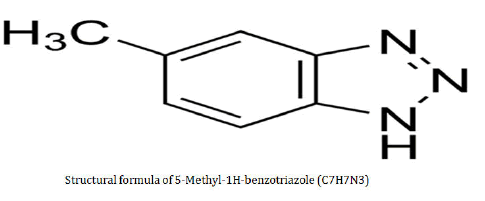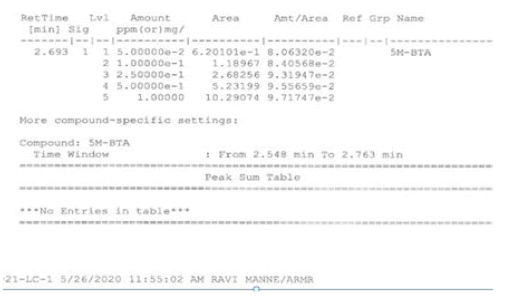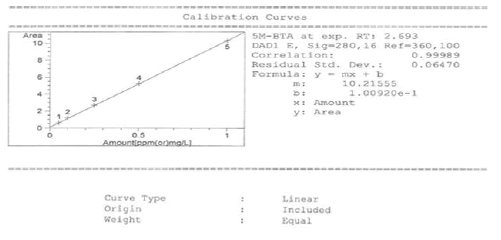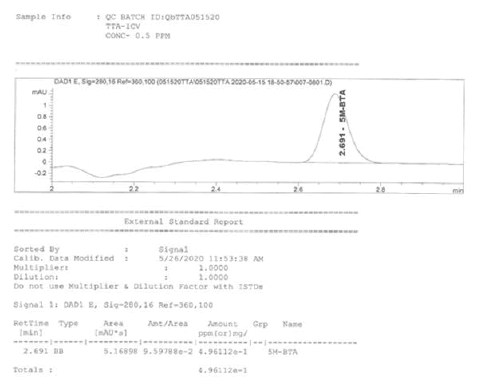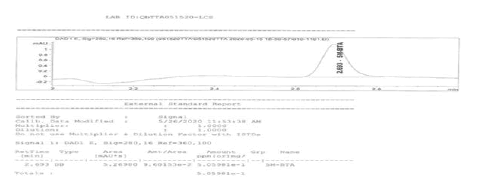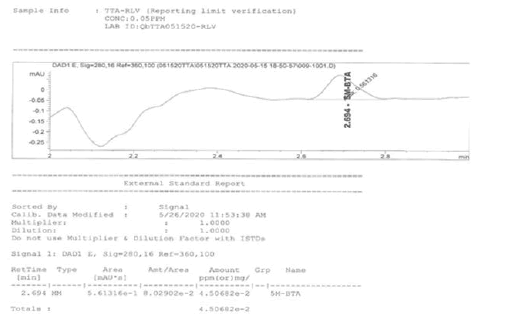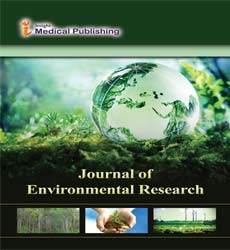5-Methyl-1h-Benzotriazole Emerging As Contaminant In Aqueous Environment And Development Of Analytical Method On Hplc
Ravi Manne1* , R Iska1, Rama mohana reddy Appanagari1
Chemtex Environmental & Industrial Hygiene Services, Chemtex, Port Arthur, Texas, USA
- *Corresponding Author:
- Ravi ManneChemtex Environmental & Industrial Hygiene Services, Chemtex, Port Arthur, Texas, USA; Tel: 409-728-6383, E-mail:ravimannemr@gmail.com
Received Date: June 30, 2020; Accepted date: August 18, 2021; Published date: August 28, 2021
Citation: Ravi M (2021) 5-Methyl-1h-benzotriazole emerging as contaminant in aqueous environment and development of analytical method on HPLC. J Environ Res Vol.5 No.5.
Abstract
5-methyl-1H-benzotriazole (5-MBTA) also known as 5- Methyl-1H-1,2,3-benzotriazole, Tolutriazole, 5-Tolyltriazole and 5-Methylbenzotriazole is an organic compound. Soluble in alcohol, benzene, toluene, chloroform, dimethylformamide, and most organic solvents, slightly soluble in water, soluble in hot water, soluble in alkaline aqueous solution1.
5-MBTA is a complexing agent are not only widely used as anti-corrosives, but they also used for silver protection in dish washer detergents, chemical in dyes, pharmaceutical, fungicides, dry cleaning and additive in tobacco industry. 5- MBTA may be released into the environment through the manufacturing and use of products, due to the chemical and physical properties 5-MBTA is only partially removed in wastewater treatment plants. Discharge of treated municipal wastewater and controlled over-runs of combined wastewater sewers are potential point sources for 5-MBTA in rivers. However, 5-MBTA adversely affect the human health as skin irritation, serious eye irritation, Serious eye damage and may cause respiratory irritation.
The health risk assessment unit evaluates the health risks from contaminants in drinking water sources and develops health-based guidance values for groundwater,3,5the because of these issues, for considering the safety of aqueous environment and to protect humans from harmful effects of 5-MBTA, manufacturers closely need to monitor and control the residual 5-MBTA content in potable and non-potable waters
High Performance Liquid Chromatography (HPLC) technique is one of the choices to measure free 5-MBTA in Sewage treatment, or domestic wastewater treatment, is the process of removing contaminants from wastewater and household sewage, both runoff (effluents) and well waters. 5-MBTA is a polar compound so soluble in water on sonication for 10-15 mins, directly soluble in hot water, methanol and acetonitrile and other polar solvents. No further sample preparation is required for 5-MBTA analysis using HPLC with Diode array detector (DAD) since 5-MBTA is directly dissolved in potable and non-potable waters that increase the efficiency of laboratory process related to analysis of 5-MBTA.
Analytical method was developed for analyzing 5-MBTA on HPLC which is amazingly simple technique, this methodology simplifies sample preparation and reduces total analysis. I believe this study not only provides information to manufacturers and regulatory authorities but does at a higher level of efficacy then current methods that enables work capacity for labs. This method allows to read 5-MBTA from to 0.05 ppm.
Keywords: 5-MBTA, Aqueous environment, Health risks & safety, HPLC
Introduction
5-methyl-1H-benzotriazole (5-MBTA) also known as 5-Methyl-1H-1,2,3-benzotriazole, Tolutriazole, 5-Tolyltriazole and 5-Methylbenzotriazole is an organic compound. Soluble in alcohol, benzene, toluene, chloroform, dimethylformamide, and most organic solvents, slightly soluble in water, soluble in hot water, soluble in alkaline aqueous solution1.
It is a good corrosion inhibiter material is used for the surface purification of silver, copper, and zinc in electroplating. It has an anti-tarnishing effect. Moreover, it is a good ultraviolet light absorber and can be used as a development antifoggant for black and white film and photographic paper. It is also a corrosion inhibitor for copper and its alloys widely used in industry, but it is more toxic. The same corrosion inhibition effect can also occur in other metal materials. Such as zinc, lead, cast iron, and nickel. Also used in manufacturing of or related to machinery, for production of cement, air/spacecraft machinery, electrical machinery and industrial fluids such as hydraulic fluids, lubricating agents, functional fluids2,3,4.
The main aim of this study was on emerging 5-MBTA as aqueous contaminant and its risks, safety, and developing analytical method and determination of 5-MBTA in potable and non-potable waters using HPLC.
Risks and safety5-MBTA is a complexing agent are not only widely used as anti-corrosives, but they also used for silver protection in dish washer detergents, chemical in dyes, pharmaceutical, fungicides, dry cleaning and additive in tobacco industry. 5-MBTA may be released into the environment through the manufacturing and use of products, due to the chemical and physical properties 5-MBTA is only partially removed in wastewater treatment plants. Discharge of treated municipal wastewater and controlled over-runs of combined wastewater sewers are potential point sources for 5-MBTA in rivers. However, 5-MBTA adversely affect the human health as skin irritation, serious eye irritation, Serious eye damage and may cause respiratory irritation. Studies on laboratory animals indicate that exposure to 5-MBTA can result in decreased body weight in offspring and may result in kidney effect over the time. The health risk assessment unit evaluates the health risks from contaminants in drinking water sources and develops health-based guidance values for groundwater,3,5the because of these issues, for considering the safety of aqueous environment and to protect humans from harmful effects of 5-MBTA, manufacturers closely need to monitor and control the residual 5-MBTA content in potable and non-potable waters.
High Performance Liquid Chromatography (HPLC) technique is one of the choices to measure free 5-MBTA in Sewage treatment, or domestic wastewater treatment, is the process of removing contaminants from wastewater and household sewage, both runoff (effluents) and well waters.
Experimental5-MBTA is a polar compound so soluble in water on sonication for 10-15 mins, directly soluble in hot water, methanol and acetonitrile and other polar solvents. No further sample preparation is required for 5-MBTA analysis using HPLC with Diode array detector (DAD) since 5-MBTA is directly dissolved in potable and non-potable waters that increase the efficiency of laboratory process related to analysis of 5-MBTA.
Materials and Methods
Acetonitrile & Methanol HPLC grade, Reagent water HPLC grade, C18 Column 5um- 4.6*150mm, Disposable Syringe, 0.45-micron syringe filters, auto sampler vails.Column- C18 column, Detection wavelength – 280nm, Sample injection- 25-50ul, Mobile Phase – Isocratic ACN: Reagent water (50:50)Flow rate – 1 ml/min, Pressure – 80-140 bar
Standards and sample preparation5-MBTA 98% (CAS-NO- 136-85-6 - Lot # MKBK4430V) purchased from sigma Aldrich. Initially Stock solution (1000ppm) prepared by weighted amount (0.102g) of solid form of standard into the methanol for immediate solubility and then sub stock solution (100ppm) prepared with reagent water.
I have prepared 5 calibration standards in reagent water from above sub stock solution (100ppm) ranges from 0.05 to 1.0 mg/L.
Initial calibration verification (ICV)- All initial calibrations shall be verified with a standard obtained from a second manufacturer or a separate lot prepared independently by the same manufacturer6.
In this study standard was prepared from second lot standard which also 98% pure (Lot no -A0172515). It involves primary stock solution 1000ppm followed by sub stock 100ppm and then ICV standard prepared with a concentration of (0.5 ppm) from sub stock to verify the initial calibration by calculation of precision.
Laboratory sample or QC check Sample- A sample matrix, free from the analytes of interest, spiked with verified known amounts of analytes or a material containing known and verified amounts of analytes and taken through all sample preparation and analytical steps of the procedure unless otherwise noted in a reference method. It is generally used to establish intra-laboratory or analyst specific precision and bias or to assess the performance of all or a portion of the measurement system6. In this study known amount of standard added into reagent water form primary sub stock of (Lot # MKBK4430V) to prepare a Laboratory control sample (LCS) with a concentration of 0.5mg/L and analyzed after calibration of instrument to ensure 5-MBTA analysis able to perform using HPLC with a developed method. Evaluation of analytical method by calculation of accuracy of LCS.
Results
A small portion of the standards and samples filtered through 0.45-micron syringe and then injected into HPLC system where the analytes are separated on C18 reversed phased LC column and detected with a Diode array detector and below following results were observed.
Accuracy: A data quality indicator of analytical process involves percentage difference between obtained value vs reference value please see the below table-1 for accuracy of this method6.
Precision: It is also another quality indicator of analytical process usually expressed as standard deviation or RPD (Relative percentage difference). For this analytical method I used both obtained areas of mid calibration point vs ICV to ensure quality of calibration6.
Table 1: Initial Calibration, Quality control and method validation of analytical process.
| Parameter | True value | Obtained value /Accuracy | Precision |
|---|---|---|---|
| Correlation coefficient (R2) | - | 0.999 (figure 1& 2) | - |
| Initial calibration verification (ICV) | 0.5 | 0.496 ppm (99%) (figure 3) | 0.6% |
| Limit of quantitation (LOQ) | 0.05 | - | - |
| Laboratory Control sample (LCS) | 0.5 | 0.505 ppm (101%) (figure 4) | - |
| Limit of quantitation (LOQ) or RL verification | 0.05 | 0.045 ppm (90%) (figure 5) | - |
Figure 1 Illustrates that the retention time of 5-MBTA was 2.69 mins and the 5 levels of calibration points ranges from 0.05 ppm to 1.0 ppm with increasing of area against the amount.
A Laboratory control sample (LCS) with a concentration of 0.5mg/L and analyzed after calibration of instrument to ensure 5-MBTA analysis able to perform using HPLC with developed method. Evaluation of analytical method by calculation of accuracy of LCS.
Figure 5 Demonstrates that the RLV study. In this study first calibration point (0.05ppm) considered as reporting limit (LOQ) since it was evaluated by reporting limit verification study see the Table 1 for accuracy.
5- MBTA can enter the aqueous environment through consumer products and industrial uses. In the environment 5-MBTA can move through soil and ground water. 5-MBTA does not biodegradable easily in the environment and wastewater treatment systems partially effective at removing 5-MBTA from waste waters but not many studies have examined humans exposed to 5-MBTA5 the because of these issues, for considering the safety of aqueous environment and to protect humans from harmful effects of 5-MBTA, manufacturers and regulatory authorities closely need to monitor and control the residual 5-MBTA content in potable and non-potable waters. Analytical method was developed for analyzing 5-MBTA on HPLC which is amazingly simple technique, this methodology simplifies sample preparation and reduces total analysis. I believe this study not only provides information to manufacturers and regulatory authorities but does at a higher level of efficacy then current methods that enables work capacity for labs. This method allows to read 5-MBTA from to 0.05 ppm.
References
- National Center for Biotechnology Information. PubChem Database. 5-Methyl-1H-benzotriazole, CID=8705.
- Kiss A, Fries E (2009) Occurrence of benzotriazoles in the rivers Main, Hengstbach, and Hegbach (Germany). Environ Sci Pollut Res 16: 702-710.
- Yu P D, M Liao, YB Luo, ZG Chen (2003) Studies of Benzotriazole and Tolytriazole as Inhibitors for Copper Corrosion in Deionized Water, CORROSION 4: 314-318.
- Minnesota Department of Health Risk Assessment Unit.
- TNI Standard EL- V1M2-2016-Rev2.1: Quality Systems General Requirements.
- Minnesota department of health contaminants of emerging concern program.
Open Access Journals
- Aquaculture & Veterinary Science
- Chemistry & Chemical Sciences
- Clinical Sciences
- Engineering
- General Science
- Genetics & Molecular Biology
- Health Care & Nursing
- Immunology & Microbiology
- Materials Science
- Mathematics & Physics
- Medical Sciences
- Neurology & Psychiatry
- Oncology & Cancer Science
- Pharmaceutical Sciences
